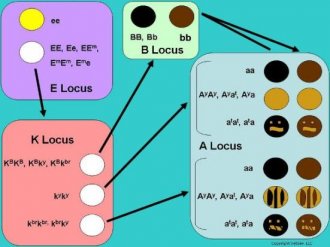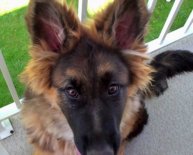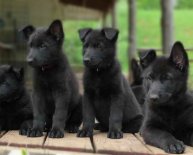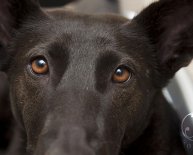
German Shepherd in black colour
For many years geneticists and breeders have been aware of several locations on the chromosomes, or loci, which are responsible for the color patterns we see in dogs and other mammals. As with all genetic traits, every animal inherits one copy of each locus from each of its parents. Each of these loci is responsible for one or more traits either independently, or in conjunction with another locus. All of them act on the pathways that produce the two major pigments, phaeomelanin and eumelanin, or affect the distribution of those pigments.
The combined effect of all these loci (Agouti, Brown, Extension, etc.) is the color of the dog. Due to the complex interactions of these genes, it is possible for dogs to carry hidden colors which may appear in their offspring. Over the past several years, scientists at VetGen and elsewhere have determined the actual genes associated with many of these loci, and identified the mutations responsible for the different versions (alleles) of these genes. The fruit of this work are the tests available for many of the common coat colors and traits.
The diagram below illustrates the relationships among the major loci (A, B, E and K) involved in determining coat color. The sections that follow describe the role these loci and others play in the coat color tests that VetGen offers. These tests demonstrate that while a dog may exhibit certain color or colors, it may also be carrying other hidden colors in its genetic code that can show up in later generations.
How do the A, B, E, and K loci affect each other in determining coat color?
The accompanying graphic helps to illustrate the interactions of the genes at these four loci in a hierarchy in terms of their role in coat color. If a circle is filled with color, it means the color of the dog has been determined at that point. If a circle is still white, it means information about an additional gene is required.

The first locus to look at is the E locus. The gene at this locus is responsible for black masks when present as well as most shades of yellow and red. Any dog that is "ee" will be some shade of yellow to red, and everything happening at the A, B, and K loci will be hidden until the next generation. If the dog has any E or Em alleles, then it will not be yellow and we must look next at the K locus.
There are three versions, or alleles, of the K locus: KB, kbr, and ky. If a dog has even a single copy of KB (KBKB, KBky, KBkbr) it will be solid colored in the pigmented areas, and we go directly to the B locus to determine color. Everything happening at the A locus in these dogs is hidden until the next generation. If a dog is kyky, it will not be brindled, and we go next to the A locus to see which alleles are expressed. If a dog is kbrkbr, or kbrky, it will nearly always be brindled and we look next at the A locus to see the background color and pattern of that brindling.











